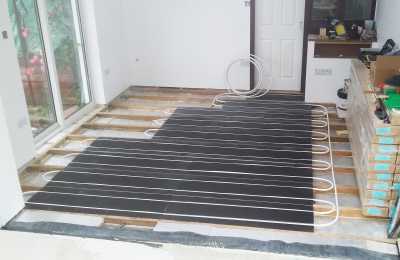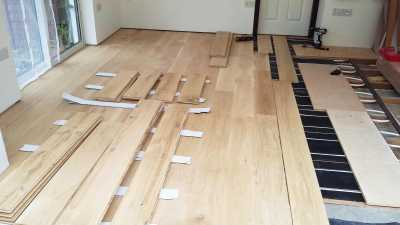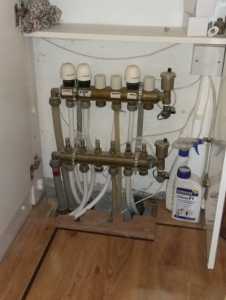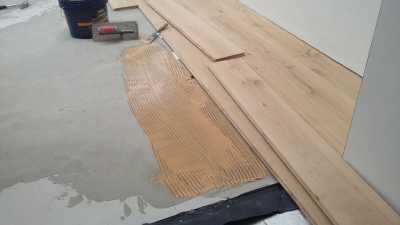Underfloor heating designer / engineer needed
I’m adding underfloor heating to my system. I have a Daikin altherma ASHP.
Any professionals on this forum that cover Bucks / Oxon (we’re north of High Wycombe and south of Thame) who could connect it in? Please message me if this is work you could quote for.
thanks
assuming the daikin is weather compensated, I am wondering why you would do this?
Professional installer
Hi @bridgetjohn and I too am intrigued.
As I'm gradually refurbishing a Devon farmhouse built in 1937, I've taken the opportunity to install UFH pipes in the new south/west extension, and all existing rooms when I get around to them. That means I've learned a lot about the practicalities over the years!
There are relatively few UFH professional installers. It's generally something which gets done as part of another task you've appointed them to do.... such as installing a boiler or heat-pump.
I have wet UFH in two types of floor
- suspended wooden floor, pipes between the joists and running through grooves in heat-spreader plates
- solid concrete slab laid on top of 100mm PIR insulation board
Running the pipework isn't the main part of the job. The two tasks which take the time are installing the insulation and fitting the final floor. So you might, for example, want a carpenter who does oak flooring.
Once the pipe loops are run back to a manifold position then you'll presumably want a heating engineer to take over.
Could you provide a bit more information here about the existing flooring type and how you want the floor to look after the pipework is in place?
Save energy... recycle electrons!
Posted by: @alec-morrowassuming the daikin is weather compensated, I am wondering why you would do this?
My assumption would be that they don’t want rads anymore and want the wall space back?
Off grid on the isle of purbeck
2.4kW solar, 15kWh Seplos Mason, Outback power systems 3kW inverter/charger, solid fuel heating with air/air for shoulder months, 10 acres of heathland/woods.
My wife’s house: 1946 3 bed end of terrace in Somerset, ASHP with rads + UFH, triple glazed, retrofit IWI in troublesome rooms, small rear extension.
The kitchen/dining and utility area had an electric underfloor mat. It was fusing quite often anyway but refitting the kitchen / utility means moving stuff and digging up the floor.
Electric floor is therefore broken.
seemed like the best plan is to replace with wet underfloor heating and let the ASHP do its thing.
We can lay the floor and do the manifold. My issue has been getting the required expert to connect it to the ASHP. Hence my post.
Floor heating with an ashp is only worth doing if the pipes are in concrete and the covering ceramic or stone
wood is a great insulator which is why it should be avoided
Professional installer
@alec-morrow You would be correct if the system was designed and installed as in the pictures above, that is a high temperature system, not suitable for a low temperature heat pump. If designed and controlled properly, it does not matter what you put on top, tyles will give a quicker reaction time, but with a heat pump, it should be run slowly gently and continually so not that important in reality.
@heacol why would controls not be compensated? I’m afraid the use of on-off controls on heat pumps and gas boilers is just nonsense and not possible in some markets like Germany and Hollaand.
with screed/ceramic/stone surfaces with pipes buried in screed your flow temp rarely needs to be above 28c, and it’s always changing.
Yes those temps can work with wood on top but there are so many variables out of anyones control from insulation to floor structure even glue type, that it’s much better just not to do it.
Use a radiator and spend the money on insulation!
Professional installer
@alec-morrow We have fantastic results with under floor with any surface when designed and installed correctly, we find weather comprnsation only works well with a thick slab and a very high thermal mass, if you do not have, a combination of weather and load compensation should be used, unfortunatly there are very few units with this option.
In most instances radiators will have a higher running costs, and unless installed in a solid stone buildings with a very high thermal masss, load compensation should be used.
In all installations, all commen areas should be open zone and the bedrooms only should be controlled to reduce the temperature to make a comfortable sleeping enviroment. This will guve the lowest running costs and best performance.
As Brendon says, the trick is in the controls
only add UFH if the daikin controller offers it and use their schematic and design (The controls may only be in more developed markets)
Don’t use third party controls
Professional installer
Posted by: @heacolif the system was designed and installed as in the pictures above, that is a high temperature system, not suitable for a low temperature heat pump.
It's an UFH system being operated from a thermal store. The water temperature leaving the store is 46degC. It then passed to the manifold for that level, and enters the UFH dissipation loop at about 43degC.
Posted by: @alec-morrowthere are so many variables out of anyones control from insulation to floor structure even glue type
Yes, the type of glue on a solid floor can be important for two reasons
- transmission of heat
- ability to flex as the wooden flooring expands & contracts more in one direction than the other
Here you can see the use of Laybond. Bostik have a technical support team who will advise customers by phone.
My situation was more complex than most because the engineered oak boards were spanning between a solid concrete pad and an area of suspended floor (above joists).
Additionally some of the pad had levelling-compound on it, whilst the rest was bare concrete with the marks of the tamping bar still evident. Bostick advised two different products to 'seal' the pad before laybond was spread on it. Only two stockists in the UK had the relevant sealers and Laybond in stock, which illustrates how specialised this work is.
The main point I took away from this exercise was to keep asking for advice from those with relevant knowledge and experience. Some sources may contradict others, but you're more likely to fail due to too little knowledge than too much!
This forum is an excellent place to gather 'opposing views' !
Save energy... recycle electrons!
@transparent What heat source do you have? Setting a constant temperature on under floor will do a number of things,
- Create a very high swing in temperature resulting in a significant waistage of energy.
- Low comfort levels resulting in a higher than required internal temperatures and the resulting loss of energy.
- Induce high degrees of frequient expansoin and contraction of all the materials.
- It reduces the efficiency of the under floor system.
In suuary, you will pay more to heat your house.
The best way is to control the room temperature with any heating system is to vary the flow temperature to achieve the required room temperature. Thes will maintain a constant floor temperature, a constant room temperature, eliminating any excessive expansion and contraction, and saving a lot of energy. You can generally run a lower room temperature if you do it this way.
It can be achieved 2 ways, firstly and the best way is to use the heating applienc's controlls as they are desogned to get the best out of the equipment, If this is not possible, use a modulating blending system to blent the water temperature to the required in real time, a standard under floor heating blending and pump pack does not do this and is very expensive to run. Use the controllers thermostat and leave the under floor system open zone. Only control the bedrooms. This will supply the best comfort levels at the lowest running cost. Under floor takes a long time to react, therefor set-backs, tumers and the likes are not suitable.
I hope this helps.
- 26 Forums
- 2,396 Topics
- 54.3 K Posts
- 122 Online
- 6,077 Members
Join Us!
Worth Watching
Latest Posts
-
RE: Help me keep the faith with my air source heat pump installation
@simonf I’ll ask the installers to get them out. What k...
By AdamK , 4 hours ago
-
RE: Recommended home battery inverters + regulatory matters - help requested
Thanks for all the help/comments. I completely agree w...
By JamesPa , 6 hours ago
-
RE: ASHP Energy Consumption: Aira 12kW heat pump
I doubt that matters, ToU tariffs are for the benefit o...
By JamesPa , 11 hours ago
-

RE: Free Ecoheat Heat Pump Install
@deltona Yes older houses are problematic like that, bu...
By bontwoody , 14 hours ago
-
RE: Radiator sizing sanity check
As I mentioned early on the cost of supplying and fitti...
By JamesPa , 17 hours ago
-
RE: Advice for a novice on Mitsubishi Ecodan 6kW
I hadn't spotted that there were two pumps in the UFH (...
By JamesPa , 18 hours ago
-
RE: Setback savings - fact or fiction?
Never assume it makes an ass of u and me! You need the...
By JamesPa , 18 hours ago
-
RE: New Mitsubishi Ecodan 11.2kW installation - L9 errors and maybe more
Before I answer your specific questions just one more t...
By JamesPa , 19 hours ago
-
RE: Electricity price predictions
Great point, one of the key ones in my chat with Octopu...
By Batpred , 1 day ago
-
RE: Running from backup generaor in powercut?
Definitely and professionals sometimes miss it. I had...
By Batpred , 1 day ago
-

RE: New Fogstar 15.5kWh upright solution
Let me point out that there are many Chinese suppliers ...
By Transparent , 1 day ago
-

RE: Weather compensation- why you should use it
@majordennisbloodnok — The Two Ronnies Mastermind sketc...
By cathodeRay , 1 day ago
-
Just realised that this image of the cylinder cupboard ...
By Sheriff Fatman , 2 days ago
-

RE: Rodents! A word of warning for heat pump owners
Two thoughts: 1: Let's ask @david-s if Primary Pro in...
By Transparent , 2 days ago
-
RE: Solis S6-EH1P8K-L-PLUS – Why I Chose It and What I’ve Learned So Far
In the diagram below, I describe my understanding of th...
By Batpred , 2 days ago
-
I need to have a look out for it. I know IBM feeds some...
By Batpred , 2 days ago
-
-
RE: Daikin Atherma ASHP Cycling 6 Times an Hour?
Thanks for your reply. Yes that's a good idea to try a...
By John Marshall , 2 days ago
-

RE: Hot water heating in parallel with space heating
An external heat exchanger would need a pump which woul...
By bontwoody , 2 days ago
-
RE: Gen 6 Samsung ASHP losing 20C of DHW in 60 min directly after generation
@ecobaker Thanks for this. I've had it in both slots. ...
By andbeck , 2 days ago









